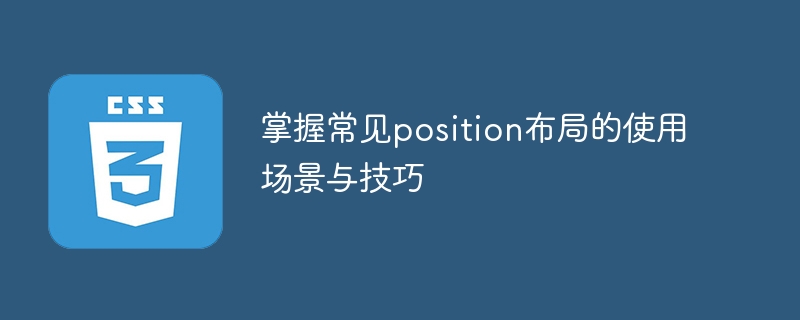

To master the usage scenarios and techniques of common position layout, specific code examples are required
Introduction:
In front-end development, layout is a crucial part . The position layout plays an important role in realizing the layout of web pages. It can help us achieve precise positioning of page elements and the realization of interactive effects. This article will introduce common usage scenarios and techniques of position layout, and provide specific code examples to help readers better master the techniques of position layout.
1. What is position layout
Position layout is a positioning method in CSS, which allows us to more accurately control the position of HTML elements on the page. Common position values include static, relative, absolute and fixed. Below we will introduce in detail the usage scenarios and techniques of these position values.
<div style="position: static;"> 这是一个静态定位的元素 </div>
<div style="position: relative; top: 20px; left: 10px;"> 这是一个相对定位的元素 </div>
<div style="position: relative;">
<div style="position: absolute; top: 20px; left: 10px;">
这是一个绝对定位的元素
</div>
</div><div style="position: fixed; top: 20px; left: 10px;"> 这是一个固定定位的元素 </div>
2. Usage scenarios and techniques of position layout
After understanding the basic knowledge of position layout, below we will introduce some common usage scenarios and techniques of position layout.
<div style="position: relative;"> <button style="position: absolute; top: 0; right: 0;">按钮</button> </div>
<div style="position: relative; width: 200px; height: 200px;"> <div style="position: absolute; top: 50px; left: 50px; width: 100px; height: 100px; background-color: red; z-index: 10;"></div> <div style="position: absolute; top: 100px; left: 100px; width: 100px; height: 100px; background-color: blue; z-index: 1;"></div> </div>
<nav style="position: fixed; top: 0; left: 0; width: 100%; background-color: #f1f1f1;"> 导航栏 </nav>
Summary:
This article introduces the usage scenarios and techniques of position layout in front-end development, and provides specific code examples. By mastering the usage skills of position layout, we can better master the positioning of page elements and the realization of interactive effects. I hope this article will be helpful to readers in their layout work in front-end development.
The above is the detailed content of Analysis of application scenarios and techniques of common position layouts. For more information, please follow other related articles on the PHP Chinese website!
 How to build a database in MySQL
How to build a database in MySQL
 okex trading platform app official website
okex trading platform app official website
 Ouyi trading platform app
Ouyi trading platform app
 How to register for corporate Alipay
How to register for corporate Alipay
 c++sort sorting function usage
c++sort sorting function usage
 How to convert html to txt text format
How to convert html to txt text format
 What are digital currency exchanges?
What are digital currency exchanges?
 what is it
what is it
 How to solve the problem that suddenly all folders cannot be opened in win10
How to solve the problem that suddenly all folders cannot be opened in win10




